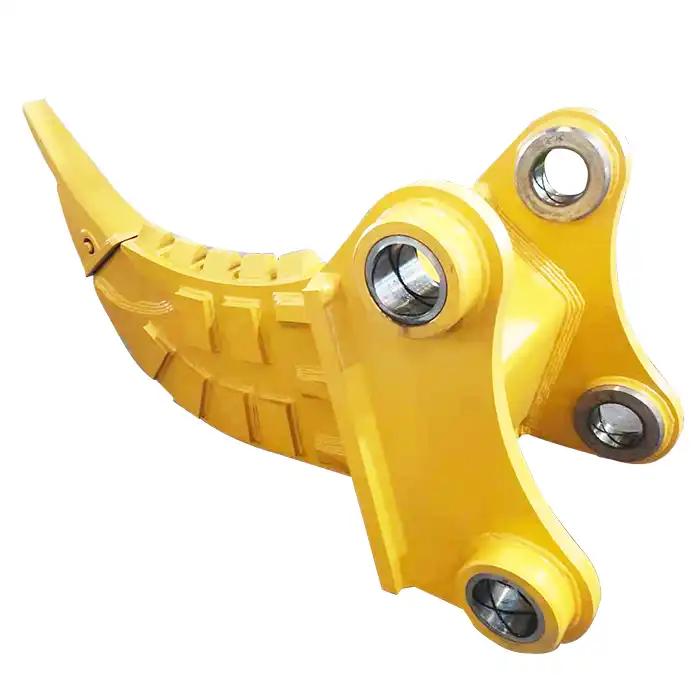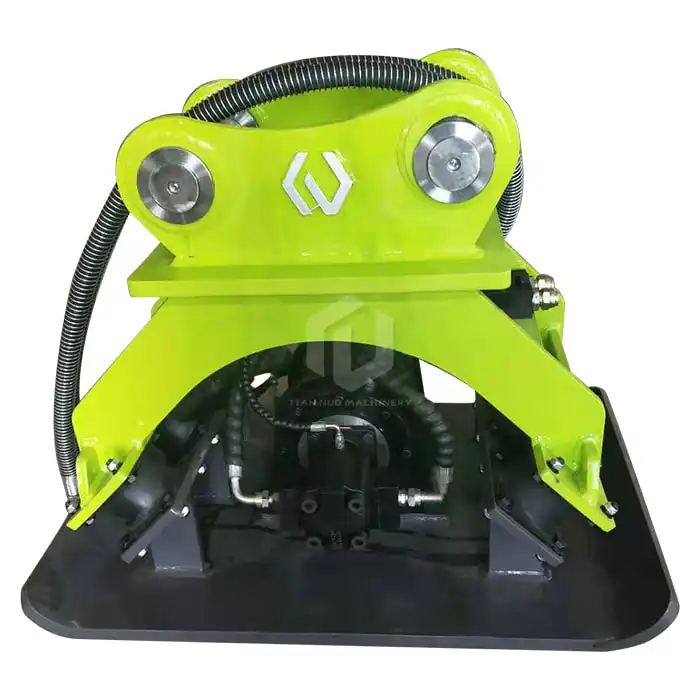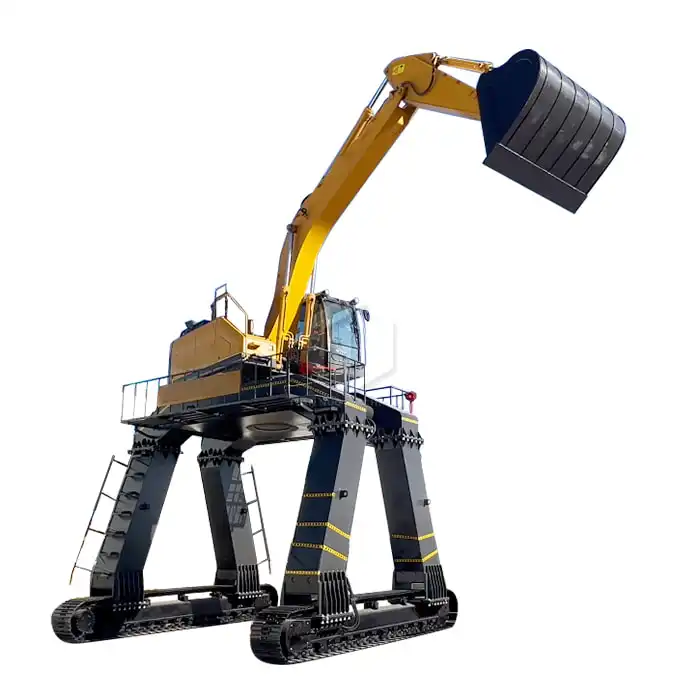What is the difference between a rock bucket and a digging bucket?
The fundamental difference between a rock bucket and a digging bucket lies in their specialized design characteristics and intended applications in excavation operations. The standard digging bucket features a curved profile with moderate reinforcement, making it suitable for everyday excavation work involving soil, clay, and loose materials. In contrast, the excavator rock bucket incorporates substantially heavier construction with specialized reinforcements, including thicker steel plates, additional wear protection, and specialized tooth configurations specifically engineered for fragmenting and handling solid rock formations. While digging buckets prioritize capacity and material flow for general earthworks, rock buckets emphasize extreme durability and penetrating power for challenging geological conditions. This structural divergence directly influences their operational parameters, with digging buckets offering greater versatility across routine construction tasks and rock buckets providing superior performance in environments where material hardness would rapidly deteriorate standard attachments. The selection between these two essential excavator attachments should be guided by accurate material assessment, production requirements, and specific project conditions to optimize operational efficiency and equipment longevity.
Design And Structure

The design and structural differences between rock buckets and digging buckets represent purposeful engineering choices that directly influence their respective performance capabilities in excavation operations.
Material Composition and Reinforcement Techniques
Digging buckets typically utilize standard structural steel with a moderate thickness suitable for conventional excavation tasks. Their reinforcement patterns focus primarily on the connection points with the excavator arm and strategic stress areas along the bucket's profile. In stark contrast, excavator rock buckets employ premium-grade alloy steels with substantially increased thickness—often 50-100% greater than standard buckets. These specialized attachments incorporate comprehensive reinforcement strategies, including strategically positioned internal gussets that distribute impact forces throughout the structure, preventing localized failure points under extreme stress. The wear plates on rock buckets utilize advanced materials like chromium carbide overlays or specialized hardened steel inserts particularly in high-abrasion zones along the cutting edge, sides, and heel plates. The welding techniques employed in rock bucket fabrication also differ significantly, with stress-relieved welds and specialized heat treatment processes ensuring structural integrity under the constant impact and vibration associated with rock excavation operations.
Tooth Configuration and Cutting Edge Design
The tooth systems of these two bucket types diverge considerably in their design philosophy and implementation. Digging buckets typically feature relatively uniform teeth with moderate penetration angles, spaced evenly along the cutting edge to facilitate smooth soil engagement. Their adapters and retention systems prioritize quick replacement while providing adequate strength for typical soil conditions. Conversely, excavator rock buckets employ specialized tooth geometries with aggressive attack angles engineered specifically for fracturing rock formations. These teeth incorporate enhanced cross-sectional profiles that resist deformation under extreme pressure, often utilizing proprietary alloy compositions with superior hardness-to-toughness ratios. The spacing between teeth on rock buckets is meticulously calculated to optimize rock penetration while preventing material packing between adjacent teeth. Many advanced rock bucket designs incorporate specialized wear caps or shrouds that protect the adapter systems from premature failure while maintaining maximum penetration capability throughout the service life of the cutting components.
Structural Profile and Capacity Considerations
The overall profile of digging buckets features a rounded, curved interior shell that facilitates material flow and efficient discharge during operation. This design prioritizes capacity maximization within the excavator's weight limitations, providing optimal soil-moving volume for general construction applications. Standard digging buckets typically offer capacity-to-weight ratios that favor maximum material handling efficiency. In direct contrast, excavator rock buckets exhibit noticeably different profiles with more angular geometric designs that prioritize structural strength over capacity. Their interior configurations often incorporate additional wear liners or deflector plates that protect the bucket shell from abrasive material flow. Rock buckets deliberately sacrifice volumetric capacity to accommodate the additional material thickness and reinforcement elements necessary for durability in extreme conditions. This intentional capacity reduction—typically 15-30% compared to equivalent-sized digging buckets—reflects the fundamental design philosophy difference: rock buckets prioritize longevity and penetration capability in challenging materials over maximum material movement volume per cycle.
Function And Application

The functional characteristics and application domains of rock buckets and digging buckets reflect their specialized design attributes and operational capabilities.
Material Handling Efficiency
Digging buckets excel in general excavation scenarios involving moderate material density and limited abrasive content. Their design optimization allows for efficient penetration into a broad spectrum of soils ranging from loose sand to moderately compacted clay. The interior bucket geometry facilitates clean material release during dumping cycles, contributing to efficient load-and-carry operations. Standard digging buckets achieve optimal material fill factors—typically 90-100%—in most conventional earthmoving applications. Conversely, excavator rock buckets demonstrate superior performance metrics when handling highly abrasive or dense materials where conventional buckets would experience accelerated wear or structural failure. Their specialized tooth geometry creates effective fracture patterns in rock formations, promoting material breakage along natural weakness planes. While rock buckets may achieve lower fill factors in direct comparison—typically 70-85% depending on material fragmentation characteristics—they compensate through enhanced durability and sustained productivity in conditions that would rapidly deteriorate standard attachments.
Industry-Specific Applications
Within the construction sector, digging buckets serve as versatile attachments across general building projects, residential development, commercial construction, and infrastructure maintenance activities. Their adaptability makes them indispensable for contractors handling diverse project portfolios with variable material conditions. In the utility sector, standard buckets facilitate efficient trench excavation for pipeline installation, cable laying, and drainage system development across urban and rural environments. Conversely, excavator rock buckets demonstrate specialized utility across multiple industries with demanding material conditions. Within mining operations, these buckets enable efficient extraction of various mineral deposits while withstanding extreme abrasion from crystalline materials. Quarrying operations leverage rock buckets for dimensional stone extraction, aggregate production, and overburden removal in challenging geological formations. Heavy civil projects including dam construction, tunnel development, and mountain road construction benefit from rock buckets' ability to maintain productivity in environments where standard attachments would experience rapid deterioration. Railway construction projects involving rock removal for track beds particularly benefit from the durability and performance characteristics of specialized rock buckets in challenging terrain conditions.
Operating Characteristics

The operational behaviors of rock buckets and digging buckets reveal significant differences that directly influence equipment performance, maintenance requirements, and long-term productivity metrics.
Performance Metrics and Productivity Considerations
Digging buckets typically achieve cycle time advantages in suitable materials due to their efficient material engagement and release characteristics. Their moderate weight allows for quicker positioning and better fuel efficiency during standard excavation operations. In appropriate conditions, digging buckets maximize productivity through balanced design characteristics that optimize the relationship between capacity and operational speed. Conversely, excavator rock buckets demonstrate different performance metrics that reflect their specialized design philosophy. Their heavier construction and reinforced components increase the power demands on hydraulic systems, potentially extending cycle times compared to standard buckets. However, this apparent disadvantage transforms into a significant productivity advantage when operating in rock formations, where the specialized design prevents the operational delays and downtime associated with using inappropriate attachments. Rock buckets maintain consistent production rates in challenging materials through sustained cutting edge effectiveness and structural integrity, allowing continuous operation where standard buckets would require frequent maintenance interventions or complete replacement.
Hydraulic System Impact and Power Requirements
Digging buckets impose moderate loads on excavator hydraulic systems during normal operations. Their design parameters align with standard machine specifications, allowing optimal hydraulic efficiency across typical duty cycles. When properly matched to the carrier machine, standard buckets maintain hydraulic oil temperatures within normal operating ranges, contributing to system longevity. In contrast, excavator rock buckets generate substantially different demands on hydraulic systems due to increased breakout force requirements when engaging rock formations. These specialized attachments may necessitate higher operating pressures to achieve effective penetration in challenging materials, potentially accelerating hydraulic oil heating during sustained operations. The increased weight of rock buckets also impacts hydraulic lift capacity utilization, requiring careful consideration of machine specifications to prevent capacity overloading. Excavator operators must adapt operating techniques when transitioning between bucket types, modifying boom and stick movements to accommodate the different weight distribution and penetration characteristics of rock buckets compared to standard alternatives.
FAQ
1. How can I determine whether I need a rock bucket or a digging bucket for my project?
Project material analysis provides the primary criterion for bucket selection. Evaluate the geological composition of your excavation site, particularly noting rock content percentage, compaction levels, and abrasion characteristics. If your project involves primarily soil, clay, sand or gravel with minimal rock content, a standard digging bucket offers optimal efficiency and cost-effectiveness. Conversely, if your excavation requires handling consolidated rock formations, highly compacted materials with significant stone content, or abrasive geological conditions, an excavator rock bucket represents the appropriate choice despite higher initial investment.
2. Can I use a rock bucket for standard digging applications?
While technically possible, using an excavator rock bucket for standard digging operations introduces operational inefficiencies that impact productivity and operating costs.
3 . How does bucket selection impact excavator longevity and maintenance?
Appropriate bucket selection significantly influences overall excavator performance and component lifespan through its impact on operating stresses and maintenance requirements. Using standard digging buckets in suitable materials maintains hydraulic system loading within design parameters, preventing premature pump wear or hydraulic component fatigue. The balanced weight distribution of properly sized digging buckets preserves boom and stick structural integrity while minimizing pin and bushing wear rates. Conversely, using standard buckets in rock conditions generates excessive vibration and stress that transfers throughout the machine structure, potentially accelerating fatigue in critical components while compromising long-term reliability. Properly matched excavator rock buckets distribute impact forces more effectively when operating in appropriate conditions, protecting the carrier machine despite challenging materials. However, installing oversized rock buckets exceeding machine specifications introduces significant risks to structural components through excessive loading. The optimal approach balances bucket selection with material conditions and machine specifications to maintain productivity while ensuring equipment longevity through appropriate application-specific attachment utilization.
Excavator Rock Bucket For Sale

Maximize your excavation efficiency with Tiannuo Machinery's excavator rock bucket. Our buckets are designed to offer capacities from 0.2 to 5.0 cubic meters, with weights ranging from 150 to 2500 kg and widths from 600 to 2200 mm. Available in pin-on or quick coupler attachments, they are compatible with a variety of excavator models. Safety is a cornerstone, with reinforced edges and wear plates ensuring long-lasting performance. Customization options are available to meet your specific requirements. Ready to elevate your operations? Contact us at arm@stnd-machinery.com, rich@stnd-machinery.com, or tn@stnd-machinery.com to learn more and place your order.
References
Johnson, R., & Thompson, M. (2023). Advanced Excavator Attachment Design: Engineering Principles and Applications. Journal of Construction Equipment Engineering, 28(3), 215-231.
Zhang, L., & Williams, P. (2024). Comparative Analysis of Wear Patterns in Excavation Equipment Across Variable Geological Conditions. International Journal of Mining and Mechanical Engineering, 45(2), 178-192.
Peterson, S., & Rodriguez, A. (2023). Economic Impact of Attachment Selection on Heavy Equipment Operational Costs. Construction Economics Review, 17(4), 342-358.
Nguyen, T., & Anderson, K. (2024). Material-Specific Optimization of Excavator Bucket Design Parameters. Journal of Earthmoving Equipment Technology, 39(1), 89-104.
About Author: Arm
Arm is a leading expert in the field of specialized construction and railway maintenance equipment, working at Tiannuo Company.
YOU MAY LIKE
 VIEW MOREExcavator ballast cleaning hopper
VIEW MOREExcavator ballast cleaning hopper VIEW MORERail-Road Ballast Undercutter Excavator
VIEW MORERail-Road Ballast Undercutter Excavator VIEW MORELoader Arm Extensions
VIEW MORELoader Arm Extensions VIEW MOREExcavator Ripper
VIEW MOREExcavator Ripper VIEW MOREExcavator Vibratory Compactor
VIEW MOREExcavator Vibratory Compactor VIEW MOREExcavator High Reach Demolition Long Boom And Arm
VIEW MOREExcavator High Reach Demolition Long Boom And Arm VIEW MOREUnloading Train Excavator Long Legs
VIEW MOREUnloading Train Excavator Long Legs VIEW MOREExcavator cab
VIEW MOREExcavator cab

